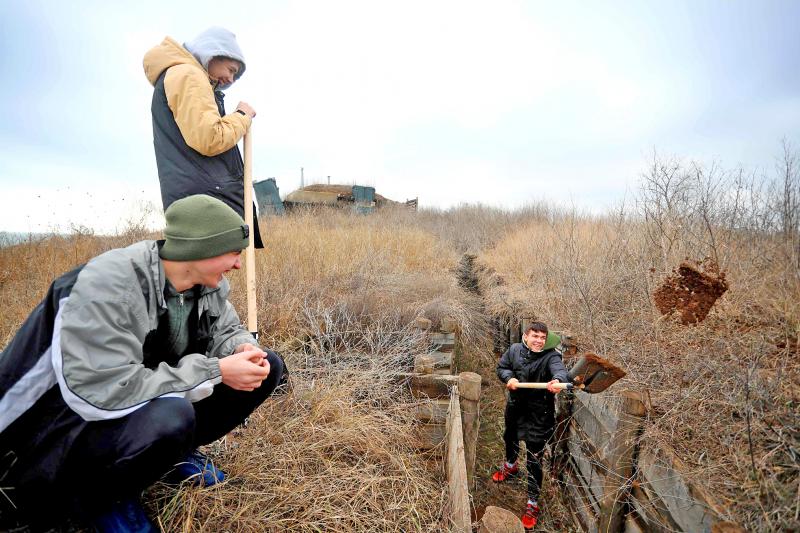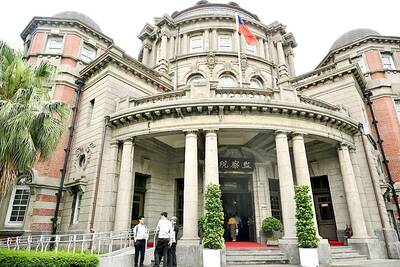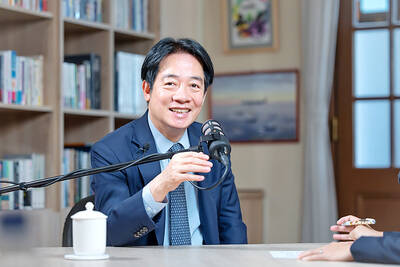Russia yesterday said that it was pulling back some of its forces near the Ukrainian border to their bases, in what could be the first major step toward de-escalation in weeks of crisis with the West.
Moscow released few details and there was no immediate outside confirmation of the withdrawal, which the Kremlin said had always been planned, despite Western “hysteria” over a feared invasion of Ukraine.
It came amid an intense diplomatic effort to avert a war in Europe after Russia amassed more than 100,000 troops on the borders of its pro-Western neighbor.

Photo: AFP
Western leaders accused Moscow of preparing for a possible invasion, a claim Russia repeatedly denied, and threatened wide-ranging sanctions if an attack took place.
NATO Secretary-General Jens Stoltenberg said in Brussels that there were “grounds for cautious optimism” in signs coming from Russia, but added: “We have not seen any sign of de-escalation on the ground.”
In Moscow, German Chancellor Olaf Scholz became the latest world leader to meet with Russian President Vladimir Putin, sitting for talks with the Kremlin leader that were to finish with a news conference later yesterday.
On the streets of the Ukrainian capital, Kiev, residents enjoying bright winter sunshine were warily optimistic, and grateful that Ukraine and its allies appeared to have held their nerve.
“There is no panic in society... You see how many people are walking around, they are all smiling, they are all happy,” lawyer Artem Zaluznyi, 22, said on the city’s main thoroughfare, Khreschatyk Street.
However, there was also caution, with many doubting that Russia would honor any promise to withdraw.
“To believe it fully would be neither smart nor wise,” Zaluznyi said.
The crisis — the worst between Russia and the West since the Cold War — reached a peak this week, with US officials warning a full-scale invasion, including an assault on Kiev, was possible within days.
Washington took the dramatic step on Monday of relocating its embassy in Kiev to the western city of Lviv, after previously urging US citizens to leave the nation.
A Russian Ministry of Defense spokesman yesterday said that some forces deployed near Ukraine had completed their exercises and were packing up to leave.
“Units of the southern and western military districts, having completed their tasks, have already begun loading onto rail and road transport, and today they will begin moving to their military garrisons,” ministry chief spokesman Igor Konashenkov said in a statement.
The ministry released a video that it said showed Russian tanks climbing on to rail cars to leave an area where drills had been taking place.
It was not immediately clear how many units were involved and what impact the withdrawals would have on the overall number of troops near Ukraine, but it was the first announcement of a Russian drawdown in weeks.
Konashenkov said “large-scale” Russian military drills were continuing in many areas, including joint exercises in Belarus, and naval exercises in the Black Sea and elsewhere.
Russian Ministry of Foreign Affairs spokeswoman Maria Zakharova said that yesterday’s news would show it was the West that had been ratcheting up tensions.
“February 15, 2022, will go down in history as the day Western war propaganda failed. Humiliated and destroyed without a single shot being fired,” Zakharova wrote on social media.
Kremlin spokesman Dmitry Peskov told reporters that the pullback was the “usual process” after military exercises and again blamed the West for the crisis.
“This is nothing but a totally unprecedented campaign to provoke tensions,” he said, calling decisions to move embassies to western Ukraine “ostentatious hysteria.”
Ukraine said that it would watch to see if any Russian withdrawal was real.
“We have a rule: Don’t believe what you hear, believe what you see. When we see a withdrawal, we will believe in a de-escalation,” Ukrainian Minister of Foreign Affairs Dmytro Kuleba told reporters.

Nvidia Corp yesterday unveiled its new high-speed interconnect technology, NVLink Fusion, with Taiwanese application-specific IC (ASIC) designers Alchip Technologies Ltd (世芯) and MediaTek Inc (聯發科) among the first to adopt the technology to help build semi-custom artificial intelligence (AI) infrastructure for hyperscalers. Nvidia has opened its technology to outside users, as hyperscalers and cloud service providers are building their own cost-effective AI chips, or accelerators, used in AI servers by leveraging ASIC firms’ designing capabilities to reduce their dependence on Nvidia. Previously, NVLink technology was only available for Nvidia’s own AI platform. “NVLink Fusion opens Nvidia’s AI platform and rich ecosystem for

WARNING: From Jan. 1 last year to the end of last month, 89 Taiwanese have gone missing or been detained in China, the MAC said, urging people to carefully consider travel to China Lax enforcement had made virtually moot regulations banning civil servants from making unauthorized visits to China, the Control Yuan said yesterday. Several agencies allowed personnel to travel to China after they submitted explanations for the trip written using artificial intelligence or provided no reason at all, the Control Yuan said in a statement, following an investigation headed by Control Yuan member Lin Wen-cheng (林文程). The probe identified 318 civil servants who traveled to China without permission in the past 10 years, but the true number could be close to 1,000, the Control Yuan said. The public employees investigated were not engaged in national

ALL TOGETHER: Only by including Taiwan can the WHA fully exemplify its commitment to ‘One World for Health,’ the representative offices of eight nations in Taiwan said The representative offices in Taiwan of eight nations yesterday issued a joint statement reiterating their support for Taiwan’s meaningful engagement with the WHO and for Taipei’s participation as an observer at the World Health Assembly (WHA). The joint statement came as Taiwan has not received an invitation to this year’s WHA, which started yesterday and runs until Tuesday next week. This year’s meeting of the decisionmaking body of the WHO in Geneva, Switzerland, would be the ninth consecutive year Taiwan has been excluded. The eight offices, which reaffirmed their support for Taiwan, are the British Office Taipei, the Australian Office Taipei, the

CAUSE AND EFFECT: China’s policies prompted the US to increase its presence in the Indo-Pacific, and Beijing should consider if this outcome is in its best interests, Lai said China has been escalating its military and political pressure on Taiwan for many years, but should reflect on this strategy and think about what is really in its best interest, President William Lai (賴清德) said. Lai made the remark in a YouTube interview with Mindi World News that was broadcast on Saturday, ahead of the first anniversary of his presidential inauguration tomorrow. The US has clearly stated that China is its biggest challenge and threat, with US President Donald Trump and US Secretary of Defense Pete Hegseth repeatedly saying that the US should increase its forces in the Indo-Pacific region